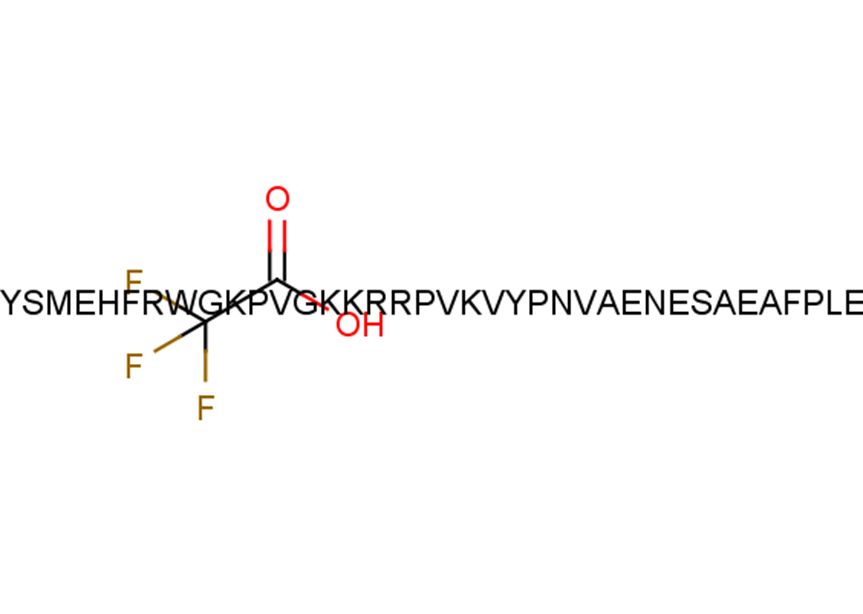keep away from moisture
Powder: -20°C for 3 years | In solvent: -80°C for 1 year

Adrenocorticotropic Hormone (ACTH) (1-39), rat (TFA) is a potent melanocortin 2 receptor (MC2) agonist.

| Pack Size | Availability | Price/USD | Quantity |
|---|---|---|---|
| 1 mg | Inquiry | $ 197.00 | |
| 5 mg | Inquiry | $ 797.00 | |
| 10 mg | Inquiry | Inquiry | |
| 50 mg | Inquiry | Inquiry |
| Description | Adrenocorticotropic Hormone (ACTH) (1-39), rat (TFA) is a potent melanocortin 2 receptor (MC2) agonist. |
| In vitro | ACTH 1-39, within the concentration range of 100-400 nM, exhibits no cytotoxic effects on neurons and notably safeguards them against excitotoxic neuronal death triggered by various agents such as glutamate (100 μM), NMDA (1 mM), AMPA (50 μM), and kainate (25 μM), with the 400 nM concentration ensuring substantial protection across all instances. Similarly, ACTH at both 200 and 400 nM concentrations effectively shields neurons from the detrimental effects of quinolinic acid (25 μM). Furthermore, ACTH mitigates cell mortality caused by 2 μM H2O2, which leads to the production of reactive oxygen species (ROS), with protection being notably greater at 400 nM than at 200 nM. Additionally, ACTH offers limited defense against the immediate release of nitric oxide (NO) by NOC-12, albeit it does not counter the slow release by NOC-18. Moreover, at concentrations of 200 or 400 nM, ACTH affords neuronal protection from the cytotoxic impacts of staurosporine (10-20 nM), a well-established inducer of apoptosis, consequently reducing cell death from 80% to 55% [1]. |
| In vivo | Intracerebroventricular (icv) administration of ACTH notably lowers total food consumption over the study period in comparison to the saline/IgG control group. Introducing ACTH antibody (Ab) into the paraventricular nucleus (PVN) negates ACTH's appetite-suppressing effect. Conversely, ACTH's icv infusion markedly reduces food intake in rats also receiving α-MSH Ab in the PVN, aligning their consumption levels with rats given ACTH icv and IgG in the PVN. Moreover, injecting either ACTH Ab or α-MSH Ab into the PVN significantly boosts food intake relative to animals treated with IgG alone [2]. |
| Animal Research | Male Wistar rats (weight range 225-250 g at purchase) are used throughout the study. Animals receive a PVN application of ACTH Ab (2 μg/rat) or IgG (2 μg/rat); administration of either ACTH (1 nM/rat) or saline icv is performed 5 min later [2]. |
| Synonyms | ACTH (1-39) (mouse, rat) TFA |
| Molecular Weight | 4696.18 |
| Formula | C212H316F3N57O59S |
| CAS No. | T10251 |
keep away from moisture
Powder: -20°C for 3 years | In solvent: -80°C for 1 year
You can also refer to dose conversion for different animals. More
bottom
Please see Inhibitor Handling Instructions for more frequently ask questions. Topics include: how to prepare stock solutions, how to store products, and cautions on cell-based assays & animal experiments, etc.
Adrenocorticotropic Hormone (ACTH) (1-39), rat TFA T10251 Others Adrenocorticotropic Hormone (ACTH) (139), rat TFA Adrenocorticotropic Hormone (ACTH) , rat TFA ACTH TFA ACTH Adrenocorticotropic Hormone (ACTH) (1 39), rat TFA ACTH (1-39) (mouse, rat) TFA inhibitor inhibit
